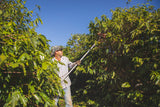Tasting Notes: Brown sugar, stone fruits & strawberry
Process: Sugarcane
Varietal: Yellow Bourbon, Catuaí, Catucaí
Altitude: 1000 - 1300MASL
Region: Sul de Minas, Minas Gerais
The rolling hills of Minas Gerais and delicate climates make it an ideal place to grow coffee in Brazil. The flat landscape makes harvesting coffee easier compared to countries with steep slopes, with some producers using machine harvesters to pick cherries. It is here where the region of Poços de Caldas is situated, which is located on the rim of an extinct volcano.The soils here are rich with volcanic minerals, and the higher altitudes make this a great place for locals to maintain coffee farms.
Poços de Caldasis home to a collection of coffee producers who have been growing coffee since 1860. Over time, producers learned how to grow coffee and efficiently maintain their farms. Quality became more of a consideration in the 1990s, and producers began to take more care during cultivation, harvesting, and processing. The coffee harvest usually lasts from the end of May to September. In this area of Brazil, coffee is primarily naturally processed, roughly 80%. Each farm contributing coffee to this lot processed their own coffee at their farms. This is typically done on a patio after the harvest. Coffee is part of tradition here, and farmers typically harvest by hand. This is not too common in Brazil, as mechanized harvesting is more of the norm due to the flat landscapes.Once the dried cherries reach their ideal moisture content, the producers deliver their coffee to Bourbon to be hulled, assessed and prepared for export.
This lot underwent the Ethyl Acetate decaffeination process, also known as the Sugarcane Decaf or Natural Decaf Process. Sugars from sugarcane are fermented to create ethyl alcohol. This is then mixed with acetic acid to create ethyl acetate.The EA decaffeination process begins with a pretreatment steaming the coffee beans at a low pressure to remove the silver skin, or the thin layer of skin on the coffee beans. The coffee beans are then moistened with hot water to swell and soften, to catalyze the hydrolysis (the chemical breakdown of a substance due to reaction with water) of the caffeine. Essentially, the caffeine is bonded to chlorogenic acid inside the coffee, and this process breaks them apart to remove the caffeine. The beans are then moved through an extractor, where they are repeatedly washed with the natural solvent, ethyl acetate. This occurs several times in order to remove 97% of the caffeine content within the coffee. Then, a flow of low-pressure steam is passed over the beans to remove any remaining ethyl acetate, which will evaporate at 70°C once the coffee beans are roasted. Lastly, the coffee is vacuum-dried until the moisture content of the coffee is brought back to the original moisture level when it arrived at the EA processing facility–typically between 10-12%.
Free delivery on all order £25 or over.
Information provided by Mercanta Limited










